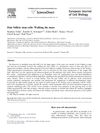From Hair to Cornea: Toward the Therapeutic Use of Hair Follicle-Derived Stem Cells in the Treatment of Limbal Stem Cell Deficiency
October 2010
in “
Stem Cells
”
TLDR Hair follicle stem cells can help treat eye surface issues by becoming corneal cells.
This study explored the use of murine vibrissae hair follicle bulge-derived stem cells (HFSCs) for treating limbal stem cell deficiency (LSCD), a condition causing severe ocular surface abnormalities. Using a transgenic mouse model, researchers demonstrated that HFSCs could differentiate into corneal epithelial cells, marked by the expression of Krt12, and successfully reconstruct the ocular surface in 80% of the 31 transplanted mice. The HFSCs not only repopulated the corneal stem cell pool but also suppressed vascularization and conjunctival ingrowth. These findings suggested that HFSCs had significant therapeutic potential for LSCD treatment, emphasizing the importance of the stem cell niche in determining differentiation outcomes.

